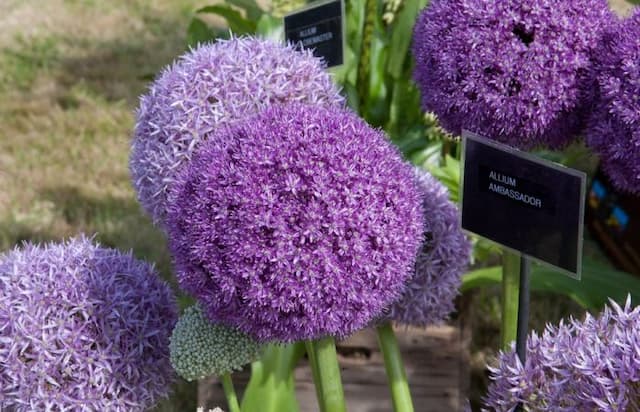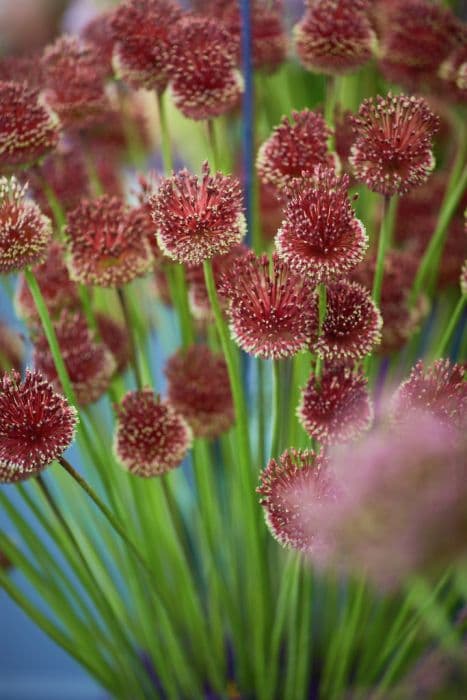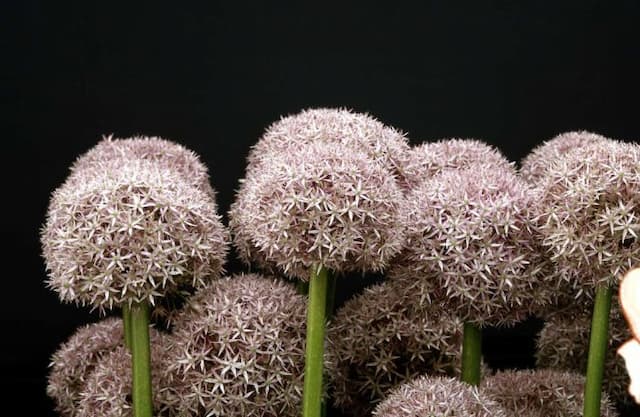Golden garlic Allium moly 'Jeannine'

ABOUT
Allium moly 'Jeannine' is known by its common name, golden garlic. This plant produces bright yellow blooms that form in clusters on top of sturdy, green stems. Each flower head is an umbel, meaning it is made up of multiple small, star-shaped flowers that create a dome-like shape collectively. The flowers are vibrant and can add a splash of color to any garden setting. The foliage of golden garlic resembles slender, strappy leaves that emerge from the base, offering a lush green backdrop to the vivid yellow blooms above. The leaves may have a glossy appearance and are typically a bright, fresh green color, which contrasts nicely with the flower heads. This plant tends to bloom in late spring to early summer, depending on the climate. Golden garlic is recognized not only for its ornamental appeal but also for its resilience and ability to thrive in various garden conditions, displaying a charming and cheerful presence wherever planted.
About this plant
 Names
NamesFamily
Amaryllidaceae
Synonyms
Golden Garlic, Lily Leek, Moly
Common names
Allium moly.
 Toxicity
ToxicityTo humans
Allium moly 'Jeannine', commonly known as Golden Garlic, is not considered highly toxic to humans. However, as with many members of the Allium family, ingestion in large quantities may lead to gastrointestinal discomfort, such as nausea, vomiting, or diarrhea. The plant contains compounds that can be mildly toxic if consumed in large amounts. Therefore, while occasional small amounts might not cause serious harm, it is advisable to avoid ingesting this plant as a precaution.
To pets
Golden Garlic is toxic to pets, notably cats and dogs, similar to other members of the Allium genus. Consumption of the plant can lead to symptoms like gastrointestinal irritation, lethargy, abdominal pain, vomiting, and diarrhea. In more severe cases, ingestion can result in damage to red blood cells, leading to hemolytic anemia, which is characterized by symptoms like pale gums, rapid breathing, weakness, jaundice, and in extreme cases, it can be fatal. Therefore, pets should not be allowed to consume any parts of this plant.
 Characteristics
CharacteristicsLife cycle
Perennials
Foliage type
Deciduous
Color of leaves
Green
Flower color
Yellow
Height
1 foot (30 cm)
Spread
1 foot (30 cm)
Plant type
Bulb
Hardiness zones
3-9
Native area
Europe
Benefits
 General Benefits
General Benefits- Easy to Grow: Allium moly 'Jeannine' is a low-maintenance plant that's easy to grow in a variety of soil types and climates.
- Attracts Pollinators: This plant produces bright yellow flowers that attract bees, butterflies, and other beneficial pollinators to the garden.
- Drought Tolerant: Once established, it has good drought tolerance, making it suitable for xeriscaping or dry gardens.
- Deer Resistant: The foliage and flowers emit a scent that deters deer, making it an excellent choice for gardens in areas with deer populations.
- Multiplication: It can naturally multiply over time, producing additional bulbs that can be divided and planted elsewhere.
- Long Blooming: Allium moly 'Jeannine' has a long blooming period in late spring to early summer, providing extended color in the garden.
- Ornamental Appeal: The striking yellow blooms and green foliage add visual interest and aesthetic appeal to borders, beds, and containers.
- Edible: Some parts of the plant, such as the bulbs and flowers, are edible and can be used in culinary applications (though not as commonly as other Allium species).
- Low Pest Issues: It is not generally prone to significant pest problems, which reduces the need for chemical treatments.
- Mixed Plantings: Serves as an excellent companion plant to other perennials, adding contrast and diversity to the garden design.
 Medical Properties
Medical PropertiesThis plant is not used for medical purposes.
 Air-purifying Qualities
Air-purifying QualitiesThis plant is not specifically known for air purifying qualities.
 Other Uses
Other Uses- Allium moly 'Jeannine', commonly known as Golden Garlic, can be used as a natural dye, with the flowers capable of producing a range of yellow hues on fabrics.
- The plant's strong scent can deter rodents and deer, so planting Golden Garlic around a garden can protect other plants from being eaten.
- Golden Garlic can be planted alongside roses to enhance their growth and health, as it is believed to deter some pests that harm rose bushes.
- The stalks of Golden Garlic can be used in floral arrangements to provide a unique, architectural element to bouquets or decorations.
- The dried seed heads of Allium moly 'Jeannine' can be used as everlasting flowers for craft projects or as decorative additions to wreaths.
- Golden Garlic can be used in companion planting to help reduce the nematode population in the soil, benefiting neighboring vegetable crops.
- Elementary educational programs can use Golden Garlic to teach children about plant biology and the lifecycle of bulbs through observation and hands-on gardening.
- Photographers and artists sometimes utilize the striking form and color of Golden Garlic as a subject for their work, enhancing the aesthetic of their visual pieces.
- Because of its hardiness, Allium moly 'Jeannine' can be used in xeriscaping, a landscaping method that requires minimal irrigation.
- The plant can serve as an indicator of soil health, as it tends to thrive in well-draining soil with ample sunlight, prompting gardeners to adjust their soil management practices accordingly.
Interesting Facts
 Feng Shui
Feng ShuiGolden Garlic is not used in Feng Shui practice.
 Zodiac Sign Compitability
Zodiac Sign CompitabilityGolden Garlic is not used in astrology practice.
 Plant Symbolism
Plant Symbolism- Protection: Alliums, also known as flowering onions, have a reputation for protecting gardens against pests due to their strong scent, which is believed to extend to symbolic protection against evil and harm in various cultural folklore.
- Purity and Blessing: The bright yellow flowers of 'Jeannine' can symbolize purity, light, and blessings, as yellow often conveys a sense of joy and new beginnings.
- Perseverance and Strength: Alliums are hardy plants that can grow in difficult conditions, symbolizing the ability to overcome adversity and embody resilience.
- Unity and Humility: The spherical shape of the allium flowerhead, composed of many small flowers, can represent unity, togetherness, and humility in some traditions due to its structure.
 Water
WaterGolden Garlic needs moderate watering during its growing season. Water the plant once a week with about 0.5 gallons of water, ensuring the soil is moist but not waterlogged. During the dormant period in winter, reduce watering to once every two or three weeks, just enough to prevent the soil from drying out completely. Always check the top inch of soil for dryness before watering and adjust your schedule according to temperature and weather conditions.
 Light
LightGolden Garlic thrives in full sunlight, so place it in an area where it can receive at least 6 hours of direct sun daily. They perform best when they have plenty of light, helping them develop strong stems and vibrant blooms. Avoid areas with shaded or dappled light to ensure the plant receives consistent sunlight throughout the day.
 Temperature
TemperatureGolden Garlic prefers a temperature range between 55°F and 75°F, which is ideal for its growth. The plant can tolerate temperatures as low as 28°F but avoid exposing it to frost, as it could damage the foliage and flowers. It is hardy up to USDA Hardiness Zone 3, meaning it can withstand minimum temperatures of -35°F to -40°F.
 Pruning
PruningPrune Golden Garlic after it has flowered by cutting back spent flower stems to maintain a tidy appearance and encourage new growth. Pruning is not typically required for overall plant health but doing so can prevent self-seeding if it's not desired. The best time for pruning is late summer, once the flowering has ceased.
 Cleaning
CleaningAs needed
 Soil
SoilGolden Garlic thrives in well-drained soil mixed with compost and sand to improve drainage. Aim for a pH between 6.0 and 7.0 for optimal growth.
 Repotting
RepottingGolden Garlic does not typically require frequent repotting and can be repotted every few years as the bulbs multiply or if the soil quality degrades.
 Humidity & Misting
Humidity & MistingGolden Garlic prefers moderate ambient humidity but is quite adaptable and does not require specific humidity conditions.
 Suitable locations
Suitable locationsIndoor
Ensure bright light, well-draining soil, and not too warm temperature.
Outdoor
Plant in well-draining soil under full or partial sun exposure.
Hardiness zone
3-9 USDA
 Life cycle
Life cycleAllium moly 'Jeannine', commonly known as golden garlic or lily leek, begins its life as a bulb planted in the fall, which then undergoes a period of dormancy over the winter. With the arrival of spring, the bulb sends up shoots and linear, green leaves, followed by clusters of bright yellow star-shaped flowers on sturdy stems by late spring to early summer. After flowering, the plant sets seed, and the flowers fade, while the foliage begins to yellow and wither as the plant enters a period of senescence. The seeds can fall to the ground and potentially germinate if conditions are right, producing new bulbs over time. The parent bulb, now dormant, remains in the ground, preserving the energy it needs to regenerate the next spring. This annual cycle of growth, flowering, and dormancy repeats each year, allowing Allium moly 'Jeannine' to spread and maintain its presence in the garden.
 Propogation
PropogationPropogation time
Spring-Early Summer
Propogation: Allium moly 'Jeannine', commonly known as Golden Garlic, is typically propagated by dividing the bulbs. The most popular and effective time to do this is in late summer to early fall, after the foliage has died back, but before the ground freezes. To propagate, carefully lift the clumps of bulbs from the ground using a garden fork, being mindful not to damage the bulbs. Gently separate the individual bulbs from the clump, ensuring that each bulb retains some of the basal plate and roots. Replant the bulbs immediately at a spacing of 4 to 6 inches (10 to 15 centimeters) apart and at a depth that is three times the height of the bulb, with the pointed end facing upwards. Water them in well after planting to encourage root development before the onset of winter.









